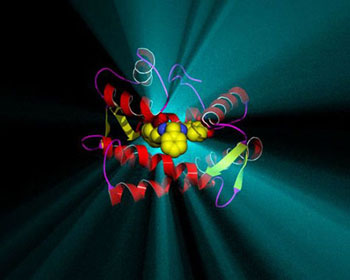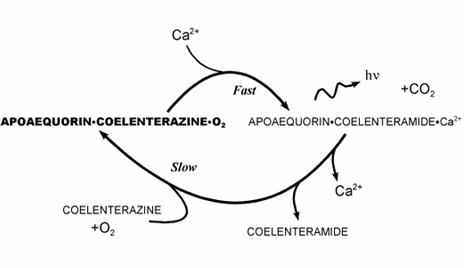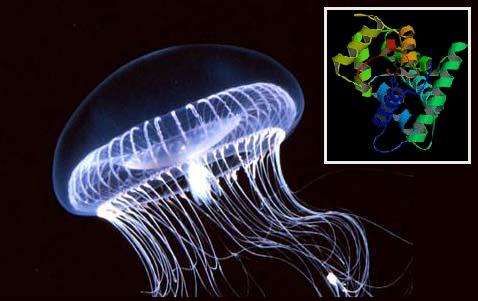Team:Valencia/WetLab/YeastTeam
From 2009.igem.org
| Line 6: | Line 6: | ||
== '''WetLab Overview''' == | == '''WetLab Overview''' == | ||
| - | < | + | <div align="justify" style="position:relative; top:-5px; left:30px; width:700px; color:black; font-size:10pt; font-family: Verdana"> |
| + | At WetLab we are working with '''yeasts''' in order to create each and everyone of the cell-pixels of our bioscreen. Since we want to make yeasts shine, we are using an aequorin-transformed yeast strains. | ||
| - | |||
| + | '''Aequorin''' is a luminiscent protein that originally was isolated from luminescent jellyfish ''Aequorea''. It can also find in other species of ''Aequorea'' and in many other marine organisms. For more information about de discovery of aequorin, read [https://2009.igem.org/Team:Valencia/A_short_story '''A short story of Aequorin'''], written by [https://2009.igem.org/Team:Valencia/A_short_story/Osamu Osamu Shimomura]. This is an interesting and entertaining text. You should read it. No doubt! | ||
| - | + | ||
| + | To make light, Aequorin uses '''coelenterazine''' as its cofactor. Aequorin also needs the binding of Ca<SUP>2+</SUP> to produce light. You can see the complete reaction in the next picture: | ||
| Line 22: | Line 24: | ||
<b>[https://2009.igem.org/Image:Aquorin_val.JPG Aequorin]</b> + <b>[https://2009.igem.org/Image:Coelenterazine.png Coelenterazine]</b> + Ca<SUP>2+</SUP> --> [[Image:Aquorin in action.jpg|350px]] | <b>[https://2009.igem.org/Image:Aquorin_val.JPG Aequorin]</b> + <b>[https://2009.igem.org/Image:Coelenterazine.png Coelenterazine]</b> + Ca<SUP>2+</SUP> --> [[Image:Aquorin in action.jpg|350px]] | ||
| - | |||
| - | + | We will use a '''chemical input''' like KOH (alkali shock) to open '''Ca<SUP>2+</SUP> channels''' in the yeasts' membrane (Viladevall L, et al. J Biol Chem. (2004) 279 43614–43624), then Ca<SUP>2+</SUP> will enter into the cells and we will get '''light''' as an '''output'''. We have a [https://2009.igem.org/Team:Valencia/WetLab/YeastTeam/Protocols protocol] and diferent [https://2009.igem.org/Team:Valencia/WetLab/YeastTeam/Experimental experimental designs] to try to reproduce the Arinyo's experiment. | |
| - | + | If we succed in this, we will try to reproduce the same response with an '''electrical stimulus''', using some hardware built by ourselves. We will use an electrical input to open the Ca<SUP>2+</SUP> channels. We hope that we see light by this metod. | |
| + | </div> | ||
[[Image:Wiki.JPG|400px|center]] | [[Image:Wiki.JPG|400px|center]] | ||
| - | |||
| - | |||
<br><br><br> | <br><br><br> | ||
Revision as of 06:35, 20 October 2009
WetLab Overview
At WetLab we are working with yeasts in order to create each and everyone of the cell-pixels of our bioscreen. Since we want to make yeasts shine, we are using an aequorin-transformed yeast strains.
Aequorin is a luminiscent protein that originally was isolated from luminescent jellyfish Aequorea. It can also find in other species of Aequorea and in many other marine organisms. For more information about de discovery of aequorin, read A short story of Aequorin, written by Osamu Shimomura. This is an interesting and entertaining text. You should read it. No doubt!
To make light, Aequorin uses coelenterazine as its cofactor. Aequorin also needs the binding of Ca2+ to produce light. You can see the complete reaction in the next picture:
Aequorin + Coelenterazine + Ca2+ --> 
We will use a chemical input like KOH (alkali shock) to open Ca2+ channels in the yeasts' membrane (Viladevall L, et al. J Biol Chem. (2004) 279 43614–43624), then Ca2+ will enter into the cells and we will get light as an output. We have a protocol and diferent experimental designs to try to reproduce the Arinyo's experiment.
If we succed in this, we will try to reproduce the same response with an electrical stimulus, using some hardware built by ourselves. We will use an electrical input to open the Ca2+ channels. We hope that we see light by this metod.
 "
"

